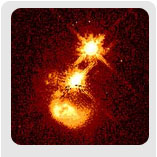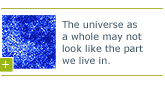 |
 |
No one knows how the first space, time, and matter
arose. And scientists are grappling with even deeper questions.
If there was nothing to begin with, then where did the laws of
nature come from? How did the universe "know" how to
proceed? And why do the laws of nature produce a universe that
is so hospitable to life? As difficult as these questions are,
scientists are attempting to address them with bold new ideas -
and new experiments to test those ideas.
Understanding how the universe began requires developing a better
theory of how space, time, and matter are related. In physics,
a theory is not a guess or a hypothesis. It is a mathematical model
that lets us make predictions about how the world behaves. Einstein's
theory of gravity, for example, accurately describes how matter
responds to gravity in the large-scale world around us. And our
best theory of the tiny sub-atomic realm, called quantum theory,
makes very accurate predictions about the behavior of matter at
tiny scales of distance. But these two theories are not complete
and are not able to make accurate predictions about the very earliest
moments when the universe was both extremely dense and extremely
small.
Some of the best minds in physics are working on a new theory
of space, time, and matter, called "string theory," that
may help us better understand where the universe came from. String
theory is based on new ideas that have not yet been tested. The
theory assumes, for example, that the basic particles in nature
are not point particles, but are shaped like strings. And the theory
requires - and predicts - that space has more than the three dimensions
in which we move. According to one version of the theory, the particles
and forces that make up our world are confined to three dimensions
we see - except for gravity, which can "leak" out into
the extra dimensions.
String theory has led to some bizarre new scenarios for the origin
of the universe. In one scenario, the Big Bang could have been
triggered when our own universe collided with a "parallel
universe" made of these extra dimensions. Scenarios like these
are very speculative, because the string theory is still in development
and remains untested, but they stimulate astronomers to look for
new forms of evidence.
A new window on the universe: waves of gravity.
The
most promising clue to our cosmic origins may be the tiny gravity
waves set in motion during the Big Bang itself. These ripples
of gravity have eluded detection so far, but NASA aims to look
for them with the LISA mission, to be launched in the next decade.
LISA technology will be so precise that it will measure the equivalent
of the distance to the Moon to less than the width of a single
atom. The mission will be complemented by the ground-based LIGO
detector, already in operation.
Gravity waves are important because they are the only known form
of information that can reach us, undistorted, from the instant
of the Big Bang itself. The different scenarios for the early universe
make different predictions for the size and pattern of these gravity
waves. The hope is that gravity waves will help refute or support
some of these theories of the early universe. The truth is, no
one knows what we'll find. This is uncharted territory – a new
window on the universe.
Is
our universe unique?
Perhaps the most unsettling and far-reaching prediction
of string theory - and also of the inflationary universe model
- is that the universe we live in is probably not unique. The
inflationary model predicts that Big Bangs are continually taking
place in other regions of space - and string theory suggests
that these other mini-verses may be so different from our own
that even the laws of nature and the number of dimensions of
space may be different.
This notion - that the universe as whole may not look like the
part we live in - may help explain a puzzling mystery about our
own universe: Why are the constants and laws of nature just so,
and not different? For example, why is the speed of light not faster
than it is? Why are electrons so much lighter than the protons
they orbit in atoms? What we do know is that if these fundamental
laws and constants were even slightly different from what is observed,
then life as we know it would not exist. (For example,
atoms would be less stable, or stars and planets would not form.)
Traditionally, physicists have sought some logical explanation
for why the universe is as it is. But the likelihood of multiple
universes raises the possibility that nature is merely playing
dice: some universes have the right conditions for life, while
others - the vast majority - do not.
Nature is full of surprises, and this dialogue with nature has
far to go. With every generation, the universe we observe seems
to be getting larger and more wonderful. Just a few hundred years
ago, the stars we see in the night sky seemed to be the limits
of our universe. Then Galileo's telescope opened up the panorama
of stars that make up our Milky Way galaxy of stars. A mere century
ago, humanity still had not discovered that there are billions
of galaxies far beyond our own. Today, we can see as far as nature
currently allows - back to the moment of the Big Bang itself. Our
ideas and ingenuity are conjuring a universe even larger and more
varied than we had ever imagined. Is it any wonder this is a great
exploration? |
 |



|